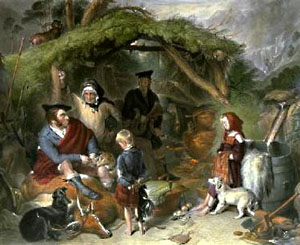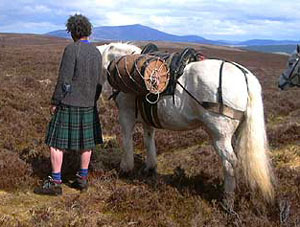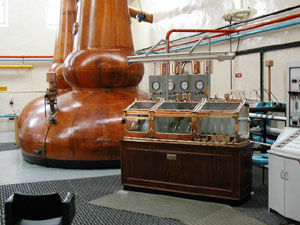| |
| |
The
Highland Whisky Smugglers |
|
|
Scots had long had a
reputation for being inveterate smugglers even before the 18th century
began. But in 1707, parliaments of Scotland and England were united and
thereafter the English system of customs duties and excise was introduced
into Scotland. Not only was this regarded as an imposition by most Scots, it
also saw a period of inefficient application of the English system. The
result was that, especially with the lucrative English market to the south,
smuggling boomed, with many from the highest to the lowest in the land
either actively participating or happy to take the benefits of it. It was
widely regarded as no crime and the resultant political corruption supported
it. Since the major goods smuggled were imported tobacco, wine, or spirits
like brandy, basically this was a nation in the grip of drug smuggling, a
condition that even today proves difficult to remedy in a modern nation. |
| |
 |
| |
An Illicit Highland Whisky
Still |
|
|
The Scots seem
to be the only nation in the world who have a major, internationally
consumed drink named after them, namely Scotch whisky. The word itself comes
from the Gaelic phrase “uisge beathat”, meaning “water of life.”. And yet
Scotch whisky as we know it did not evolve until the mid 19th century,
indeed, the British courts did not decide, exactly what Scotch whisky was
until the London Borough of Islington case in 1906! The case centred on
whether Scotch whisky had to be only malt whisky or whether it could be
mixed with grain spirit, now generally spirit distilled from maize, a crop
not normally associated with Scottish agriculture. In fairness, they also
decided that Scotch could only be Scotch after a minimum three years of
maturation. |
 |
|
|
A Highland Whisky Smuggler |
|
|
It was the introduction of
a tax on malt, an essential ingredient in the making of whisky that helped
spur on the illicit distilling of whisky – that is the distilling of whisky
without a licence, which cost a lot to purchase. As much as anything, the
driving force behind the trade, as in some countries today that grow
marijuana or other drugs was poverty. Much of the Highlands, where hundreds
of illicit stills operated, had and have low agricultural productivity. Even
the landless who could equip themselves with distilling equipment could
enter into the trade, sending their goods south in barrels, hung on long
strings of ponies, over the hill tracks and roads.
Corgarff was a major centre
of distilling as were the glens to the north of it such as Glenlivet, now
the source of a famous malt whisky from its legal distillery. |
|
A watcher on
the military road and bridges would
have seen many a long string of pack animals passing secretly by at night
carrying locally illegally distilled whisky. The government officials
charged with the responsibility to suppress the illegal trade and collect
the revenues due on the whisky, the “excise men”, were not idle. Fierce
fights developed between smugglers and the excise men they encountered and
the bridges and military road would have been the scene of some of these.
The road system, built to suppress the local population, was now actively if
illegally, used by them to support their needs. However, by the end of the
eighteenth century, the system of
military roads built by Wade and Caulfeild was falling into disrepair
and disuse. It was the communications built by thegreat Scots civil engineer
Telford, who constructed some 705 miles of new road and 1,000 bridges that
then aided the distribution of the smuggled goods. |
|
But the
activity did not meet with everyone’s approval. As the minister of Strathdon
put it in 1801, “The inhabitants of Corgarff, the glens and not a few in the
lower part of the parish were professed smugglers, The revenue officers were
set at defiance. To be engaged in illicit distillation, and to defraud the
excise, was neither looked on as a crime, nor considered as a disgrace. As
may be supposed, such a system of things proved most pernicious, productive
of the grossest demoralization, irreligion, and sin, destructive of every
habit of regular industry.”
Undoubtedly,
the profitability of illicit distilling helped maintain the populations of
remote parts of the Highlands such as Corgarff and Strathdon where our
military road is situated. The Statistical Account of Scotland of 1843
declared,” While this infamous and demoralizing
practice prevailed, population |
| |
 |
| |
A Modern Whisky Distillery
today. |
|
|
increased
through the facilities by which families were maintained in the hills and
valleys by its profits.”
By mid 19th
century however, the practice was dying out. What stopped it? Undoubtedly,
the activities of the excise men had its effect. In 1827 for example,
Corgarff castle was restored at a cost of £1,200, a huge sum in those days,
and a body of government troops, light dragoons, (mounted infantrymen) were
stationed there to suppress the smuggling. They became known as the “terror
of the smugglers” and presumably earned their reputation.
However other
measures were probably more effective. The Duke of Gordon of the day pointed
out that whisky was the natural beverage of the highlander and distilling
was in their blood. A more effective way to control the practice was to make
it cheaper to do it legally by lowering the cost of a licence to distil
whisky legally. The degree to which this illegal drug was widely supplied
made effective control impossible. Even George IV reportedly limited his
consumption to Glenlivet whisky after being offered it by a local Laird!
Legislation legalising the distillation of whisky was introduced in 1823.
Also, pressure was brought to bear on the landowners who could evict tenants
who distilled illegally and this perhaps had more impact than anything.
Today,
no whisky smugglers pass this way (we think!). Whisky has evolved from a
rather ill-defined and often not very fine drink that the smugglers carried
into the high quality “Scotch” that the world enjoys and which is one of
Scotland’s main exports. But there are fewer, far fewer people in the glens. |
| |
Acknowledgements: By John A
Duncan of Sketraw FSA Scot. adapted from an article on "An 18th century
military road in the Scottish Highlands."
The Whisky Roads of Scotland D Cooper
and F Goodwin, Pub Jill Norman and Hobhouse Ltd, 1982
The Smugglers, Duncan Fraser, Pub Montrose Standard Press, 1971
Corgarff Castle booklet written by Iain MacIvor and Chris Tabraham, edited
by Chris Tabraham, drawings by David Simon - 1993. |
|
|
|



